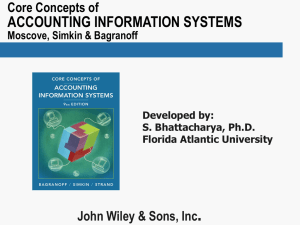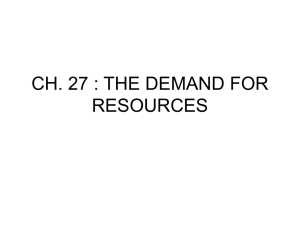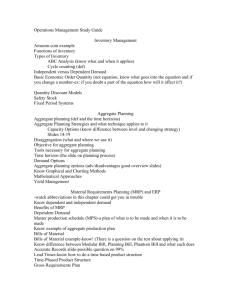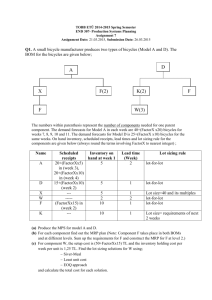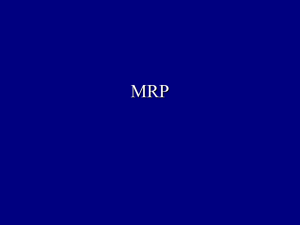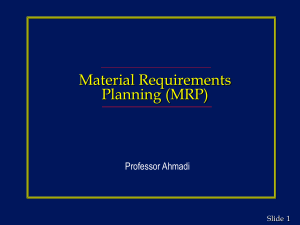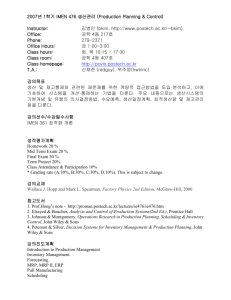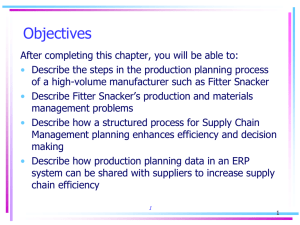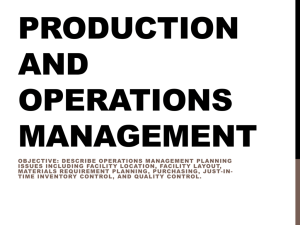Chapter 14 – Resource
advertisement
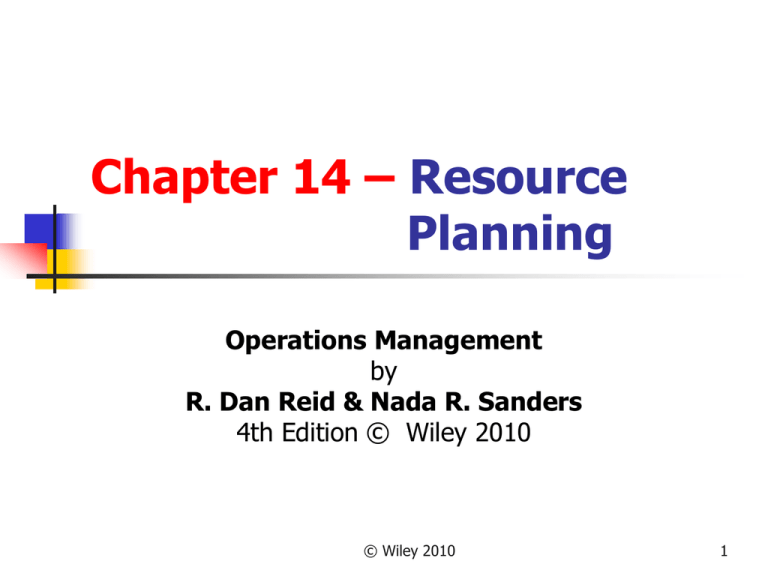
Chapter 14 – Resource Planning Operations Management by R. Dan Reid & Nada R. Sanders 4th Edition © Wiley 2010 © Wiley 2010 1 Learning Objectives Describe enterprise resource management Describe the evolution of ERP Systems Describe the benefits and costs of ERP systems Provide an overview of MRP Explain the different types of demand Describe the objectives of MRP © Wiley 2010 2 Learning Objectives con’t Describe the inputs needed for MRP Explain MRP operating logic Describe action notices Use different lot size rules with MRP Describe the role of capacity requirements planning (CRP) Calculate the work loads at critical work centers using CRP © Wiley 2010 3 Enterprise Resource Planning ERP is software designed for organizing and managing business processes Modules share information across all business functions Can share customer sales data with the supply chain to help with global replenishment All modules are fully integrated and use a common database – some PC based © Wiley 2010 4 Integration of ERP © Wiley 2010 5 ERP Modules-4 Categories Finance and accounting Sales and marketing Handles pricing, availability, orders, shipments, & billing Production and materials management Investment, cost, asset, capital, and debt management Budgets, profitability analysis, and performance reports Process planning, BOM, product costing, ECN’s, MRP, allocates resources, schedules, PO’s, & inventory Human resources Workforce planning, payroll & benefits, & org. charts © Wiley 2010 6 Evolution of ERP First generation ERP Managed all routine internal business activities From order entry to after-sales customer service Lacked supply chain support modules (added in second generation) © Wiley 2010 7 Evolution of ERP Second Generation ERP Late 1990’s software integrated supply chains Systems focused on decision-making SCM modules include linear programming (LP) and simulation support SCI capability allows collection of intelligence along the entire supply chain ASP suppliers set-up and run systems for others © Wiley 2010 8 Integrating ERP and E-Commerce Many companies with ERP use e-commerce E-commerce needs to interface with ERP Cybex International is a good example: Needed to integrate B2C and B2B transactions Cybex installed a Peoplesoft, Inc. ERP system Reduced BOM’s from 15,200 to 200, suppliers from 1000 to 550, paperwork by 2/3 Reduced supplier material shortages and customer order-to-ship time from 4 to 2 weeks © Wiley 2010 9 Benefits of ERP ERP presents a holistic view of the business functions from a single information and IT architecture Increases organizational information flow Increases ability to incorporate better management control, speedier decision making, and cost reductions Allows replacement of disparate systems e.g. ExxonMobile used ERP to replace 300 different systems A study of ERP implementations reports that benefits typically start 8 months after implementation with median annual savings of $1.6 million © Wiley 2010 10 The Cost of ERP Systems Major suppliers are SAP AG, Peoplesoft, Oracle, and Baan. Also smaller PC based suppliers. Costs for larger ERP systems range from hundreds of thousands to several million dollars. Outside consultants are usually involved in selection, configuration, & implementation. © Wiley 2010 11 The Cost of ERP Systems Consultant costs can run up to 3 times the cost of the system itself. Added costs also include additional people, new computer hardware, and the cost to develop a new, integrated database Successful implementation requires leadership and top management commitment to a vision for the business © Wiley 2010 12 Material Planning Systems MRP translated a master schedule of final products into time-phased net requirements for subassemblies, assemblies, and parts First MRP systems evolved from closed-loop MRP Closed-loop MRP included production planning, master scheduling, and capacity requirements In mid 1970’s, MRPII systems added functionality to plan and execute all internal functions © Wiley 2010 13 An Overview of MRP MRP uses the concept of backward scheduling to determine how much and when to order and replenish The CPR module checks to make sure the scheduled work load profile is feasible The MPS module contains the authorized schedule The BOM module contains the product structure for each unique product MRP output includes schedules for all internal activities and parts as well as orders for all supply chain items. © Wiley 2010 14 Input/Output - MRP Process © Wiley 2010 15 Types of Demand There are two types of demand. Independent Demand Is the demand for finished products Does not depend on the demand of other products Needs to be forecasted Dependent Demand Is the demand derived from finished products Is the demand for component parts based on the number of end items being produced and is managed by the MRP system © Wiley 2010 16 Objectives of MRP Determines the quantity and timing of material requirements Determines what to order (checks BOM), how much to order (lot size rules), when to place the order (need date minus lead time), and when to schedule delivery (on date needed) Maintain priorities In a changing environment, MRP reorganizes priorities to keep plans current and viable © Wiley 2010 17 Building a CD Cabinet With MRP © Wiley 2010 18 MRP Inputs - Authorized MPS From the authorized MPS, we calculate when we need to have replenishment orders of CD cabinets; when we need a new MPS order. Table 14-1 Initial MPS Record for CD Cabinet Item: CD Cabinet Lot size rule: FOQ=100 Lead time: 1 week Gross Requirements: Projected Available: MPS 80 1 25 55 2 25 30 3 25 5 4 25 -20 5 30 6 30 7 30 8 30 9 35 10 35 11 35 12 35 5 30 50 6 30 20 7 30 90 100 8 30 60 9 35 25 10 35 90 100 11 35 55 12 35 20 Table 14-2 Updated MPS Record for CD Cabinet Item: CD Cabinet Lot size rule: FOQ=100 Lead time: 1 week Gross Requirements: Projected Available: MPS 80 1 25 55 2 25 30 3 25 5 4 25 80 100 © Wiley 2010 19 MRP Inputs-Inventory Records System checks the inventory record for each BOM item to see if inventory is available or if a replenishment order is needed to build the cabinets. Table 14-3 First Inventory Record for CD Cabinet Item: CD Cabinet Lot size rule: L4L Lead time: 1 week Gross Requirements: Scheduled Receipts: Projected Available: Planned Orders 0 1 0 2 0 3 0 4 100 0 0 0 -100 5 0 6 0 7 100 8 0 9 0 10 100 11 0 12 0 Table 14-4 Updated Inventory Record for CD Cabinet Item: CD Cabinet Lot size rule: L4L Lead time: 1 week Gross Requirements: Scheduled Receipts: Projected Available: Planned Orders 0 1 0 2 0 3 0 4 100 5 0 6 0 7 100 8 0 9 0 10 100 11 0 12 0 0 0 0 100 0 0 0 100 0 0 0 100 0 0 0 © Wiley 2010 20 MRP Inputs-Bills of Material A BOM lists all of the items needed to produce one CD cabinet The BOM is exactly like a recipe for baking a cake The BOM’s must be complete and accurate and can only be changed by an ECN MRP BOM’s are indented bills of materials Indented BOM © Wiley 2010 21 A Product Structure Tree © Wiley 2010 22 The MRP Explosion Process Table 14-6 Updated Inventory Record for CD Cabinet Item: CD Cabinet Lot size rule: L4L Lead time: 1 week Gross Requirements: Scheduled Receipts: Projected Available: Planned Orders: Parent: none Children: Top, bottom, door, left side, right side, shelves, shelf supports 0 1 0 2 0 3 0 4 100 5 0 6 0 7 100 8 0 9 0 10 100 11 0 12 0 0 0 0 100 0 0 0 100 0 0 0 100 0 0 0 Using this table and the product structure tree, we will work through an example of how the MRP explosion process calculates the requirements for building a CD cabinet. Next we start with the cabinet top to show how MRP calculates the gross requirements for this © Wiley 2010 23 component. Inventory Records - Components It was noted on the previous slide that the parent item (CD Cabinet) has planned orders in periods 3, 6, and 9. Its children (top, bottom, door, left & right side, shelves, and supports) have gross requirements in periods 3, 6, and 9. © Wiley 2010 24 Inventory Records - Components © Wiley 2010 25 Inventory Records– Components con’t © Wiley 2010 26 Inventory Records– Components con’t © Wiley 2010 27 Inventory Records – Remaining Components © Wiley 2010 28 Inv. Records – Remaining Components con’t © Wiley 2010 29 Inv. Records – Remaining Components con’t © Wiley 2010 30 MRP Action Notices Action Notices: Indicate items that need a production planner’s attention Are created when a planned order needs to be released, due dates need to be adjusted, or when there is insufficient lead time for normal replenishment Often require planners to rush or expedite orders © Wiley 2010 31 MRP Action Notices Action Bucket: Is the current period where we take actions such as releasing, rescheduling, or canceling orders A positive quantity in current period’s planned order row means that an order must be released © Wiley 2010 32 Example Comparing Lot Size Rules: Three lot sizing rules used within MRP Systems are: fixed order quantity (FOQ), lot for lot (L4L), and period order quantity (POQ). Cost comparison is based on Inventory holding costs ($0.10/period) and ordering cost ($25/order). In this example POQ is best at $133.50. © Wiley 2010 33 Rough Cut Capacity Example: The CRP module uses data from MRP. Calculate workloads for critical work centers based on open shop orders and planned shop orders. These shop orders are translated into hours of work by work center and by time period. Table 14-11 show items scheduled for work Center 101. Available = 4 machines x 2 shifts x 10 hours x 5 days x 0.85 utiliza- x 0.95 effiCapacity per shift per wk. tion ciency Available = 323.0 standard hours Capacity © Wiley 2010 34 Workload Graph for Work Center 101: CRP enables a company to evaluate both the feasibility of the MRP system and how well the company is using its critical work centers. © Wiley 2010 35 Resource Planning within OM: How it all fits together Enterprise resource planning provides a common database for use by an organization, its suppliers, and its customers. MRP reports are used by the production and inventory planners to (1) generate purchasing requisitions and (2) develop schedules of different activities to be done on the manufacturing floor. Techniques for sequencing activities are discussed in Chapter 15. The authorized MPS, the bill of material (BOM) file, and the inventory records are inputs to the MRP system. It is critical that the MPS be feasible and that the BOM file and the inventory records be accurate. This implies that the time standards (Chapter 11) are valid and that cycle counting (Chapter 12) be used to maintain inventory record accuracy. If not, material is not ordered at the appropriate time in the right quantity. © Wiley 2010 36 Resource Planning Across the Organization Since MRP determine the quantity and timing of materials needed, it affects several functional areas Accounting future material commitments based on MRP output Marketing is primarily concerned with MPS as the MRP reveals potential material shortages Information systems maintains the MRP and the MPS © Wiley 2010 37 Chapter 14 Highlights ERP is software designed for organizing and managing all business processes by sharing information across functional areas using a common database and a single computer system. First generation ERP systems provided a single interface for managing routine activities performed in manufacturing. Second generation systems or SCM – software are designed to improve decision making in the supply chain. The current trend is integrating e-commerce and ERP. Tangible benefits from ERP include reductions in inventory and staffing, increased production, improved order management, and increased revenue and profits. © Wiley 2010 38 Chapter 14 Highlights con’t MRP systems are designed to calculate material requirements from dependent demand items. MRP systems use backward scheduling to determine activity start dates. Independent demand is the demand for finished products, whereas dependent demand is demand that is derived from finished products, MRP system use dependent demand. The objectives of MRP are to determine the quantity and timing of material requirements and to keep schedule priorities updated and valid. MPR determines what to order, how much to order, when to place the order, and when to schedule the arrival. © Wiley 2010 39 Chapter 14 Highlights con’t MRP needs three inputs: the authorized MPS, the BOM file, and the inventory records file. The MPS is the planned build schedule, the BOM files shows the materials needed to build an item, and the inventory records file shows the inventory on hand. Once the MPS has been input, MRP checks the inventory records to determine if enough end-item inventory is available. If sufficient end-item inventory is not on hand, MPR checks the end-item’s BOM file to determine what materials are needed and in what quantities. Action notices show when to release planned orders, reschedule orders, or adjust due dates. They allow the planner to use the MRP output information effectively © Wiley 2010 40 Chapter 14 Highlights con’t Different lot size rules are used with MRP systems to generate different order quantities and order frequencies. The lot-for-lot (L$L) rule always minimizes the inventory investment but maximized ordering costs. Planned orders generated by MRP, plus any open shop orders, are inputs to capacity requirements planning (CRP). CRP checks to see if available capacity is sufficient to complete the orders scheduled in a particular work center during a specific time period. CRP calculates the workloads at critical work centers by using the planned orders generated by the MRP system. These planned orders are multiplied by the standard times to calculate individual work center loads. © Wiley 2010 41 Homework Hints Problems 14.1-3, 3sp. Use the data given to: 1. 2. 3. 3sp. prepare a product structure tree. determine the product lead time. calculate gross requirements, starting with 100 units of the end item (Q). do an MRP chart—using either the excel or word chart given on the website. Assume gross requirements for Q is in period 9; assume L4L is to be used for all components. Problems 14.23-24. Do a CRP: 23. 24. Calculate the required capacity (based on each job’s set up and run times). Calculate the available capacity (based on available time for three machines adjusted for utilization and efficiency). Determine the match between required capacity (14.23) and available capacity (14.24).
